Remote Sensing Active Fire Detection Tools Support Growth Reconstruction for Large Boreal Wildfires
Abstract
:1. Introduction
- (1)
- Develop a method to estimate the day of burn for portions of individual wildfires by combining different sources of active fire detection data and using ordinary kriging.
- (2)
- Use operational burned area update data recorded by Ontario’s Ministry of Natural Resources and Forestry fire operations personnel to validate kriging results.
- (3)
- Compare results obtained via kriging of MODIS, VIIRS, and combined data to better understand how progression inference varies by data source and kriging method.
2. Materials and Methods
2.1. Wildfire Data
2.2. Active Fire Detection Data
2.3. Kriging to Estimate Wildfire Progression
2.4. Defining the Burn Period
2.5. Statistical Analysis
3. Results
3.1. Ordinary Kriging
3.2. Prediction Bias
3.3. Wildfire Case Study: RED-071-2012
4. Discussion
4.1. Fire Progression Mapping
4.2. Limitations
4.3. Future Research
5. Conclusions
Author Contributions
Funding
Data Availability Statement
Acknowledgments
Conflicts of Interest
References
- Wooster, M.J.; Zhang, Y.H. Boreal Forest Fires Burn Less Intensely in Russia than in North America. Geophys. Res. Lett. 2004, 31, 2–4. [Google Scholar] [CrossRef]
- French, N.H.F.; Goovaerts, P.; Kasischke, E.S. Uncertainty in Estimating Carbon Emissions from Boreal Forest Fires. J. Geophys. Res. Atmos. 2004, 109, D14S08. [Google Scholar] [CrossRef]
- Randerson, J.T.; Liu, H.; Flanner, M.G.; Chambers, S.D.; Jin, Y.; Hess, P.G.; Pfister, G.; Mack, M.C.; Treseder, K.K.; Welp, L.R.; et al. The Impact of Boreal Forest Fire on Climate Warming. Science 2006, 314, 1130–1132. [Google Scholar] [CrossRef]
- Adams, M.A. Mega-Fires, Tipping Points and Ecosystem Services: Managing Forests and Woodlands in an Uncertain Future. For. Ecol. Manag. 2013, 294, 250–261. [Google Scholar] [CrossRef]
- Flannigan, M.D.; Vonder Haar, T. Forest Fire Monitoring Using NOAA Satellite AVHRR. Can. J. For. Res. 1986, 16, 975–982. [Google Scholar] [CrossRef]
- Ressl, R.; Lopez, G.; Cruz, I.; Colditz, R.R.; Schmidt, M.; Ressl, S.; Jiménez, R. Operational Active Fire Mapping and Burnt Area Identification Applicable to Mexican Nature Protection Areas Using MODIS and NOAA-AVHRR Direct Readout Data. Remote Sens. Environ. 2009, 113, 1113–1126. [Google Scholar] [CrossRef]
- Hawbaker, T.J.; Vanderhoof, M.K.; Beal, Y.-J.; Takacs, J.D.; Schmidt, G.L.; Falgout, J.T.; Williams, B.; Fairaux, N.M.; Caldwell, M.K.; Picotte, J.J.; et al. Mapping Burned Areas Using Dense Time-Series of Landsat Data. Remote Sens. Environ. 2017, 198, 504–522. [Google Scholar] [CrossRef]
- Natural Resources Canada FireMARS. Available online: https://www.nrcan.gc.ca/our-natural-resources/forests/wildland-fires-insects-disturbances/fire-monitoring-reporting-tool/13159 (accessed on 10 January 2017).
- Natural Resources Canada Canadian Wildland Fire Information System. Available online: http://cwfis.cfs.nrcan.gc.ca/background/summary/fwi (accessed on 10 January 2017).
- San-Miguel-Ayanz, J.; Barbosa, P.; Liberta, G.; Schmuck, G.; Schulte, E.; Bucella, P. The European Forest Fire Information System: A European Strategy towards Forest Fire Management. In Proceedings of the Third International Wildland Fire Conference, Sydney, Australia, 3–6 October 2003. [Google Scholar]
- Copernicus Emergency Management Service Global Wildfire Information System (GWIS). Available online: http://gwis.jrc.ec.europa.eu/ (accessed on 10 January 2017).
- Robinson, J. Fire from Space: Global Fire Evaluation Using Infrared Remote Sensing. Int. J. Remote Sens. 1991, 12, 3–24. [Google Scholar] [CrossRef]
- Dozier, J. A Method for Satellite Identification of Surface Temperature Fields of Subpixel Resolution. Remote Sens. Environ. 1981, 11, 221–229. [Google Scholar] [CrossRef]
- Giglio, L.; Kendall, J.D.; Justice, C.O. Evaluation of Global Fire Detection Algorithms Using Simulated AVHRR Infrared Data. Int. J. Remote Sens. 1999, 20, 1947–1985. [Google Scholar] [CrossRef]
- Li, Z.; Kaufman, Y.; Ichoku, C.; Fraser, R.; Trishchenko, A.; Giglio, L.; Jin, J.; Yu, X. A Review of AVHRR-Based Active Fire Detection Algorithms: Principles, Limitations, and Recommendations. In Global and Regional Vegetation Fire Monitoring from Space: Planning a Coordinated International Effort; Ahern, F., Goldammer, J., Justice, C., Eds.; SPB Academic Publishing: The Hague, The Netherlands, 2001; pp. 199–225. [Google Scholar]
- Ichoku, C.; Kaufman, Y.J.; Giglio, L.; Li, Z.; Fraser, R.H.; Jin, J.-Z.; Park, W.M. Comparative Analysis of Daytime Fire Detection Algorithms Using AVHRR Data for the 1995 Fire Season in Canada: Perspective for MODIS. Int. J. Remote Sens. 2003, 24, 1669–1690. [Google Scholar] [CrossRef]
- Li, Z.; Fraser, R.; Jin, J.; Abuelgasim, A.A.; Csiszar, I.; Gong, P.; Pu, R.; Hao, W. Evaluation of Algorithms for Fire Detection and Mapping across North America from Satellite. J. Geophys. Res. Atmos. 2003, 108, 4076. [Google Scholar] [CrossRef]
- Wooster, M. Fire Radiative Energy for Quantitative Study of Biomass Burning: Derivation from the BIRD Experimental Satellite and Comparison to MODIS Fire Products. Remote Sens. Environ. 2003, 86, 83–107. [Google Scholar] [CrossRef]
- Wooster, M.J.; Roberts, G.; Perry, G.L.W.; Kaufman, Y.J. Retrieval of Biomass Combustion Rates and Totals from Fire Radiative Power Observations: FRP Derivation and Calibration Relationships between Biomass Consumption and Fire Radiative Energy Release. J. Geophys. Res. Atmos. 2005, 110, D24311. [Google Scholar] [CrossRef]
- Flasse, S.P.; Ceccato, P. A Contextual Algorithm for AVHRR Fire Detection. Int. J. Remote Sens. 1996, 17, 419–424. [Google Scholar] [CrossRef]
- Arino, O.; Simon, M.; Piccolini, I.; Rosaz, J.-M. The ERS-2 ATSR-2 World Fire Atlas and the ERS-2 ATSR-2 World Burnt Surface Atlas Projects. In Proceedings of the 8th ISPRS Conference on Physical Measurement & Signatures in Remote Sensing, Aussois, France, 8–12 January 2001. [Google Scholar]
- Kaufman, Y.J.; Justice, C.O.; Flynn, L.P.; Kendall, J.D.; Prins, E.M.; Giglio, L.; Ward, D.E.; Menzel, W.P.; Setzer, A.W. Potential Global Fire Monitoring from EOS-MODIS. J. Geophys. Res. Atmos. 1998, 103, 32215–32238. [Google Scholar] [CrossRef]
- Csiszar, I.; Schroeder, W.; Giglio, L.; Ellicott, E.; Vadrevu, K.P.; Justice, C.O.; Wind, B. Active Fires from the Suomi NPP Visible Infrared Imaging Radiometer Suite: Product Status and First Evaluation Results. J. Geophys. Res. Atmos. 2014, 119, 803–816. [Google Scholar] [CrossRef]
- Schroeder, W.; Oliva, P.; Giglio, L.; Csiszar, I.A. The New VIIRS 375 m Active Fire Detection Data Product: Algorithm Description and Initial Assessment. Remote Sens. Environ. 2014, 143, 85–96. [Google Scholar] [CrossRef]
- Agee, J.K. Fire Regimes and Approaches for Determining Fire History. In The Use of Fire in Forest Restoration; Hardy, C., Arno, S., Eds.; General Technical Report INT-GTR-341; U.S. Department of Agriculture, Forest Service, Intermountain Research Station: Ogden, UT, USA, 1996; pp. 12–13. [Google Scholar]
- Yocom Kent, L.L. An Evaluation of Fire Regime Reconstruction Methods; Working Papers in Southwestern Ponderosa Pine Forest Restoration #32; Southwest Fire Science Consortium and Ecological Restoration Institute, Northern Arizona University: Flagstaff, AZ, USA, 2014; 15p. [Google Scholar]
- Harrison, S.P.; Prentice, I.C.; Bloomfield, K.J.; Dong, N.; Forkel, M.; Forrest, M.; Ningthoujam, R.K.; Pellegrini, A.; Shen, Y.; Baudena, M.; et al. Understanding and Modelling Wildfire Regimes: An Ecological Perspective. Environ. Res. Lett. 2021, 16, 125008. [Google Scholar] [CrossRef]
- Kasischke, E.S.; Hewson, J.H.; Stocks, B.; van der Werf, G.; Randerson, J. The Use of ATSR Active Fire Counts for Estimating Relative Patterns of Biomass Burning—A Study from the Boreal Forest Region. Geophys. Res. Lett. 2003, 30, 2–5. [Google Scholar] [CrossRef]
- Loboda, T.V.; Csiszar, I.A. Reconstruction of Fire Spread within Wildland Fire Events in Northern Eurasia from the MODIS Active Fire Product. Glob. Planet. Chang. 2007, 56, 258–273. [Google Scholar] [CrossRef]
- Ester, M.; Kriegel, H.P.; Sander, J.; Xu, X. A Density-Based Algorithm for Discovering Clusters in Large Spatial Databases with Noise. In Proceedings of the Second Conference on Knowledge Discovery and Data Mining, Portland, OR, USA, 2–4 August 1996; AAAI Press: Portland, OR, USA, 1996; Volume 2, pp. 226–231. [Google Scholar]
- de Groot, W.J.; Landry, R.; Kurz, W.A.; Anderson, K.R.; Englefield, P.; Fraser, R.H.; Hall, R.J.; Banfield, E.; Raymond, D.A.; Decker, V.; et al. Estimating Direct Carbon Emissions from Canadian Wildland Fires. Int. J. Wildland Fire 2007, 16, 593–606. [Google Scholar] [CrossRef]
- Kasischke, E.S.; Hoy, E.E. Controls on Carbon Consumption during Alaskan Wildland Fires. Glob. Chang. Biol. 2012, 18, 685–699. [Google Scholar] [CrossRef]
- Thorsteinsson, T.; Magnusson, B.; Gudjonsson, G. Large Wildfire in Iceland in 2006: Size and Intensity Estimates from Satellite Data. Int. J. Remote Sens. 2011, 32, 17–29. [Google Scholar] [CrossRef]
- Veraverbeke, S.; Sedano, F.; Hook, S.J.; Randerson, J.T.; Jin, Y.; Rogers, B.M. Mapping the Daily Progression of Large Wildland Fires Using MODIS Active Fire Data. Int. J. Wildland Fire 2014, 23, 655–667. [Google Scholar] [CrossRef]
- Parks, S.A. Mapping Day-of-Burning with Coarse-Resolution Satellite Fire-Detection Data. Int. J. Wildland Fire 2014, 23, 215–223. [Google Scholar] [CrossRef]
- Giglio, L.; Schroeder, W.; Justice, C.O. The Collection 6 MODIS Active Fire Detection Algorithm and Fire Products. Remote Sens. Environ. 2016, 178, 31–41. [Google Scholar] [CrossRef]
- Loboda, T.; Hall, J. ABoVE: Wildfire Date of Burning within Fire Scars across Alaska and Canada, 2001–2015. Oak Ridge National Laboratory Distributed Active Archive Center for Biogeochemical Dynamics: Oak Ridge, TN, USA. Available online: https://doi.org/10.3334/ORNLDAAC/1559 (accessed on 10 January 2017).
- Scaduto, E.; Chen, B.; Jin, Y. Satellite-Based Fire Progression Mapping: A Comprehensive Assessment for Large Fires in Northern California. IEEE J. Sel. Top. Appl. Earth Obs. Remote Sens. 2020, 13, 5102–5114. [Google Scholar] [CrossRef]
- Crowley, M.A.; Cardille, J.A.; White, J.C.; Wulder, M.A. Multi-Sensor, Multi-Scale, Bayesian Data Synthesis for Mapping within-Year Wildfire Progression. Remote Sens. Lett. 2019, 10, 302–311. [Google Scholar] [CrossRef]
- Ban, Y.; Zhang, P.; Nascetti, A.; Bevington, A.R.; Wulder, M.A. Near Real-Time Wildfire Progression Monitoring with Sentinel-1 SAR Time Series and Deep Learning. Sci. Rep. 2020, 10, 1322. [Google Scholar] [CrossRef]
- Lasko, K. Incorporating Sentinel-1 SAR Imagery with the MODIS MCD64A1 Burned Area Product to Improve Burn Date Estimates and Reduce Burn Date Uncertainty in Wildland Fire Mapping. Geocarto Int. 2021, 36, 340–360. [Google Scholar] [CrossRef]
- Benali, A.; Russo, A.; Sá, A.; Pinto, R.; Price, O.; Koutsias, N.; Pereira, J. Determining Fire Dates and Locating Ignition Points With Satellite Data. Remote Sens. 2016, 8, 326. [Google Scholar] [CrossRef]
- Andela, N.; Morton, D.C.; Giglio, L.; Paugam, R.; Chen, Y.; Hantson, S.; van der Werf, G.R.; Randerson, J.T. The Global Fire Atlas of Individual Fire Size, Duration, Speed, and Direction. Earth Syst. Sci. Data 2018, 11, 529–552. [Google Scholar] [CrossRef]
- Artés, T.; Oom, D.; de Rigo, D.; Durrant, T.H.; Maianti, P.; Libertà, G.; San-Miguel-Ayanz, J. A Global Wildfire Dataset for the Analysis of Fire Regimes and Fire Behaviour. Sci. Data 2019, 6, 296. [Google Scholar] [CrossRef] [PubMed]
- Humber, M.; Zubkova, M.; Giglio, L. A Remote Sensing-Based Approach to Estimating the Fire Spread Rate Parameter for Individual Burn Patch Extraction. Int. J. Remote Sens. 2022, 43, 649–673. [Google Scholar] [CrossRef]
- Collins, B.M.; Kelly, M.; van Wagtendonk, J.W.; Stephens, S.L. Spatial Patterns of Large Natural Fires in Sierra Nevada Wilderness Areas. Landsc. Ecol. 2007, 22, 545–557. [Google Scholar] [CrossRef]
- Collins, B.M.; Miller, J.D.; Thode, A.E.; Kelly, M.; Van Wagtendonk, J.W.; Stephens, S.L. Interactions among Wildland Fires in a Long-Established Sierra Nevada Natural Fire Area. Ecosystems 2009, 12, 114–128. [Google Scholar] [CrossRef]
- Thompson, J.R.; Spies, T.A. Factors Associated with Crown Damage Following Recurring Mixed-Severity Wildfires and Post-Fire Management in Southwestern Oregon. Landsc. Ecol. 2010, 25, 775–789. [Google Scholar] [CrossRef]
- Birch, D.S.; Morgan, P.; Kolden, C.A.; Hudak, A.T.; Smith, A.M.S. Is Proportion Burned Severely Related to Daily Area Burned? Environ. Res. Lett. 2014, 9, 064011. [Google Scholar] [CrossRef]
- Billmire, M.; French, N.H.F.; Loboda, T.; Owen, R.C.; Tyner, M. Santa Ana Winds and Predictors of Wildfire Progression in Southern California. Int. J. Wildland Fire 2014, 23, 1119–1129. [Google Scholar] [CrossRef]
- Wang, X.; Parisien, M.; Flannigan, M.D.; Parks, S.A.; Anderson, K.R.; Little, J.M.; Taylor, S.W. The Potential and Realized Spread of Wildfires across Canada. Glob. Chang. Biol. 2014, 20, 2518–2530. [Google Scholar] [CrossRef] [PubMed]
- Parks, S.A.; Holsinger, L.M.; Miller, C.; Nelson, C.R. Wildland Fire as a Self-Regulating Mechanism: The Role of Previous Burns and Weather in Limiting Fire Progression. Ecol. Appl. 2015, 25, 1478–1492. [Google Scholar] [CrossRef] [PubMed]
- Whitman, E.; Parisien, M.-A.; Thompson, D.K.; Hall, R.J.; Skakun, R.S.; Flannigan, M.D. Variability and Drivers of Burn Severity in the Northwestern Canadian Boreal Forest. Ecosphere 2018, 9, e02128. [Google Scholar] [CrossRef]
- Baysal, I.; Ouellette, M.; Antoszek, J. Red Lake 084 of 2011: A Reconnaissance Survey of a Large Boreal Wildfire; Forest Research Information Paper 177; Ministry of Natural Resources, Ontario Forest Research Institute: Sault Ste. Marie, ON, Canada, 2011; 91p.
- Beck, J.A.; Alexander, M.E.; Harvey, S.D.; Beaver, A.K. Forecasting Diurnal Variations in Fire Intensity to Enhance Wildland Firefighter Safety. Int. J. Wildland Fire 2002, 11, 173–182. [Google Scholar] [CrossRef]
- Hall, R.J.; Skakun, R.S.; Metsaranta, J.M.; Landry, R.; Fraser, R.H.; Raymond, D.; Gartrell, M.; Decker, V.; Little, J. Generating Annual Estimates of Forest Fire Disturbance in Canada: The National Burned Area Composite. Int. J. Wildland Fire 2020, 29, 878–891. [Google Scholar] [CrossRef]
- R Core Team. R: A Language and Environment for Statistical Computing; R Foundation for Statistical Computing: Vienna, Austria, 2020; Available online: https://www.R--project.org/ (accessed on 10 January 2020).
- EOSDIS FIRMS Frequently Asked Questions. Available online: earthdata.nasa.gov/faq/firms-faq (accessed on 10 January 2017).
- Davies, D.K.; Ilavajhala, S.; Wong, M.M.; Justice, C.O. Fire Information for Resource Management System: Archiving and Distributing MODIS Active Fire Data. IEEE Trans. Geosci. Remote Sens. 2009, 47, 72–79. [Google Scholar] [CrossRef]
- Hantson, S.; Padilla, M.; Corti, D.; Chuvieco, E. Strengths and Weaknesses of MODIS Hotspots to Characterize Global Fire Occurrence. Remote Sens. Environ. 2013, 131, 152–159. [Google Scholar] [CrossRef]
- Waigl, C.F.; Stuefer, M.; Prakash, A.; Ichoku, C. Detecting High and Low-Intensity Fires in Alaska Using VIIRS I-Band Data: An Improved Operational Approach for High Latitudes. Remote Sens. Environ. 2017, 199, 389–400. [Google Scholar] [CrossRef]
- Bivand, R.; Rundel, C. Rgeos: Interface to Geometry Engine—Open Source (‘GEOS’). 2019, R Package Version 0.5-2. Available online: https://cran.r--project.org/packages=rgeos (accessed on 10 January 2020).
- Giglio, L.; Schroeder, W.; Hall, J.V.; Justice, C.O. MODIS Collection 6 Active Fire Product User’s Guide Revision C. 2020. Available online: https://modis-fire.umd.edu/files/MODIS_C6_Fire_User_Guide_C.pdf (accessed on 1 February 2021).
- Johnston, J.M. Infrared Remote Sensing of Fire Behaviour in Canadian Wildland Forest Fuels. Ph.D. Thesis, King’s College London, London, UK, 2016; 359p. [Google Scholar]
- Bivand, R.; Pebesma, E.; Gómez-Rubio, V. Applied Spatial Data Analysis with R, 2nd ed.; Springer: New York, NY, USA, 2013; ISBN 9781461476184. [Google Scholar]
- Chiles, J.-P.; Desassis, N. Fifty Years of Kriging. In Handbook of Mathematical Geosciences: Fifty Years of IAMG; Sagar, D., Cheng, Q., Agterberg, F., Eds.; Springer International Publishing: Berlin, Germany, 2018; pp. 589–612. ISBN 9783319789996. [Google Scholar]
- Holdaway, M. Spatial Modeling and Interpolation of Monthly Temperature Using Kriging. Clim. Res. 1996, 6, 215–225. [Google Scholar] [CrossRef]
- Samuel, A.; Morris, M.; Beylerian, E.; Bender-demoll, S.; Weiss, K.; Anderson, S. Sp. 2020, R Package Version 1.4-2. Available online: https://cran.r--project.org/packages=sp (accessed on 1 July 2020).
- Pebesma, E.; Graeler, B. Gstat. 2019, R Package Version 2.0-3. Available online: https://cran.r--project.org/packages=gstat (accessed on 10 January 2020).
- Spinu, V.; Grolemund, G.; Wickham, H. Package ‘lubridate’—Make Dealing with Dates a Little Easier. J. Stat. Softw. 2018, 40, 1–25. [Google Scholar]
- Werth, P.; Potter, B.; Clements, C.; Finney, M.; Goodrick, S.; Alexander, M.; Cruz, M.; Forthofer, J.; McAllister, S. Synthesis of Knowledge of Extreme Fire Behavior: Volume I for Fire Management; General Technical Report PNW-GTR-854; U.S. Department of Agriculture, Forest Service, Pacific Northwest Research Station: Portland, OR, USA, 2011; pp. 1–144.
- Werth, P.; Potter, B.; Alexander, M.; Cruz, M.; Clements, C.; Finney, M.; Forthofer, J.; Goodrick, S.; Hoffman, C.; Jolly, M.; et al. Synthesis of Knowledge of Extreme Fire Behavior: Volume 2 for Fire Behavior Specialists, Researchers, and Meteorologists; General Technical Report PNW-GTR-891; U.S. Department of Agriculture, Forest Service, Pacific Northwest Research Station: Portland, OR, USA, 2016; pp. 808–2130.
- Hijmans, R.J.; Van Etten, J.; Sumner, M.; Cheng, J.; Bevan, A.; Bivand, R.; Busetto, L.; Canty, M.; Forrest, D.; Golicher, D.; et al. Raster: Geographic Data Analysis and Modeling. 2019, R Package Version 3.4-5. Available online: https://cran.r--project.org/packages=raster (accessed on 10 January 2020).
- Wickham, H.; Chang, W.; Henry, L.; Pederson, T. Ggplot2: Elegant Graphics for Data Analysis. 2020, R Package Version 3.3.2. Available online: https://cran.r--project.org/packages=ggplot2 (accessed on 1 July 2020).
- Wilke, C.O. Ggridges: Ridgeline Plots in “Ggplot2.” 2018, R Package Version 0.5.4. Available online: https://cran.r--project.org/packages=ggridges (accessed on 1 February 2021).
- Bowman, A.; Azzalini, A. R. Sm: Nonparametric Smoothing Methods. 2018, R Package Version 2.2-5.6. Available online: https://cran.r--project.org/packages=sm (accessed on 10 January 2020).
- Bataineh, A.L.; Oswald, B.P.; Bataineh, M.; Unger, D.; Hung, I.-K.; Scognamillo, D. Spatial Autocorrelation and Pseudoreplication in Fire Ecology. Fire Ecol. 2006, 2, 107–118. [Google Scholar] [CrossRef]
- Legendre, P.; Fortin, M.J. Spatial Pattern and Ecological Analysis. Vegetatio 1989, 80, 107–138. [Google Scholar] [CrossRef]
- Moran, P.A.P. Notes on Continuous Stochastic Phenomena. Biometrika 1950, 37, 17–23. [Google Scholar] [CrossRef] [PubMed]
- Osorio, F.; Vallejos, R.; Cuevas, F. SpatialPack: Computing the Association Between Two Spatial Processes. arXiv 2016, arXiv:1611.05289. [Google Scholar]
- Osorio, F.; Vallejos, R.; Cuevas, F.; Mancilla, D. SpatialPack: Tools for Assessment the Association between Two Spatial Processes. 2022, R Package Version 0.4. Available online: https://cran.r--project.org/packages=spatialpack (accessed on 20 October 2022).
- Cohen, J. A Coefficient of Agreement for Nominal Scales. Educ. Psychol. Meas. 1960, 20, 37–46. [Google Scholar] [CrossRef]
- Cohen, J. Weighted Kappa: Nominal Scale Agreement Provision for Scaled Disagreement or Partial Credit. Psychol. Bull. 1968, 70, 213–220. [Google Scholar] [CrossRef]
- Revelle, W. Psych: Procedures for Personality and Psychological Research. 2020, R Package Version 1.9.12.31. Available online: https://cran.r--project.org/package=psych (accessed on 1 October 2021).
- Martell, D.L.; Kourtz, P.H.; Tithecott, A.; Ward, P.C. The Development and Implementation of Forest Fire Management Decision Support Systems in Ontario, Canada; General Technical Report PSW-GTR-173; U.S. Department of Agriculture, Forest Service, Pacific Northwest Research Station: Berkeley, CA, USA, 1999; pp. 131–142.
- Giglio, L.; Loboda, T.; Roy, D.P.; Quayle, B.; Justice, C.O. An Active-Fire Based Burned Area Mapping Algorithm for the MODIS Sensor. Remote Sens. Environ. 2009, 113, 408–420. [Google Scholar] [CrossRef]
- CIFFC Glossary Task Team and Training Working Group. CIFFC Canadian Wildland Fire Glossary; CIFFC: Manitoba, CA, Canada, 2021; 32p. [Google Scholar]
- Van Wagner, C.E. A Method for Computing Fine Fuel Moisture Content throughout the Diurnal Cycle; Information Report PS-X-69; Canadian Forest Service, Petawawa Forest Experiment Station: Chalk River, ON, Canada, 1977; 15p.
- Friedland, C.J.; Joyner, T.A.; Massarra, C.; Rohli, R.V.; Treviño, A.M.; Ghosh, S.; Huyck, C.; Weatherhead, M. Isotropic and Anisotropic Kriging Approaches for Interpolating Surface-Level Wind Speeds across Large, Geographically Diverse Regions. Geomat. Nat. Hazards Risk 2017, 8, 207–224. [Google Scholar] [CrossRef]
- Berman, M.T.; Ye, X.; Thapa, L.H.; Peterson, D.A.; Hyer, E.J.; Soja, A.J.; Gargulinski, E.M.; Csiszar, I.; Schmidt, C.C.; Saide, P.E. Quantifying Burned Area of Wildfires in the Western United States from Polar-Orbiting and Geostationary Satellite Active-Fire Detections. Int. J. Wildland Fire 2023, 32, 665–678. [Google Scholar] [CrossRef]
- Giglio, L. Characterization of the Tropical Diurnal Fire Cycle Using VIRS and MODIS Observations. Remote Sens. Environ. 2007, 108, 407–421. [Google Scholar] [CrossRef]
- Giglio, L.; Descloitres, J.; Justice, C.O.; Kaufman, Y.J. An Enhanced Contextual Fire Detection Algorithm for MODIS. Remote Sens. Environ. 2003, 87, 273–282. [Google Scholar] [CrossRef]
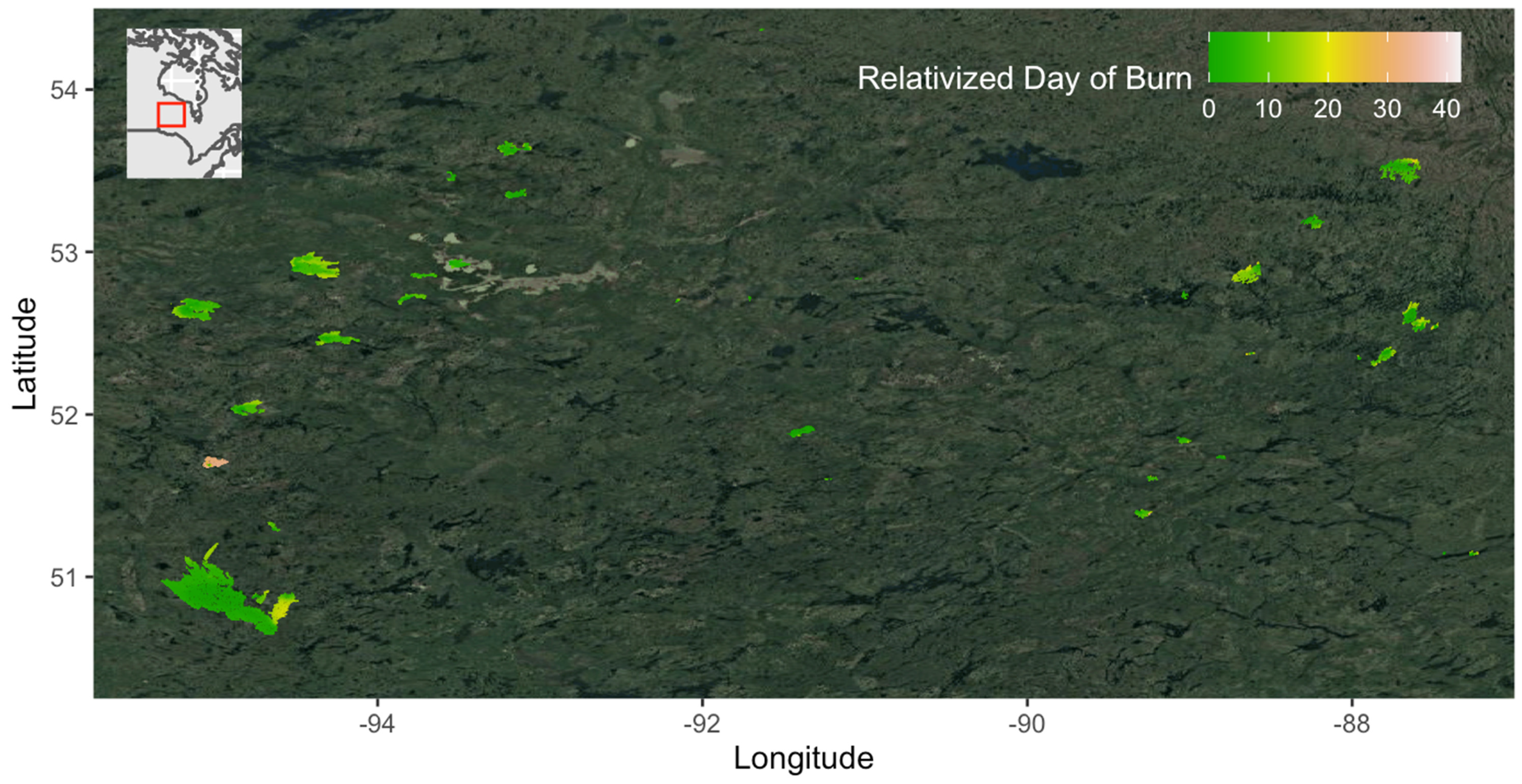
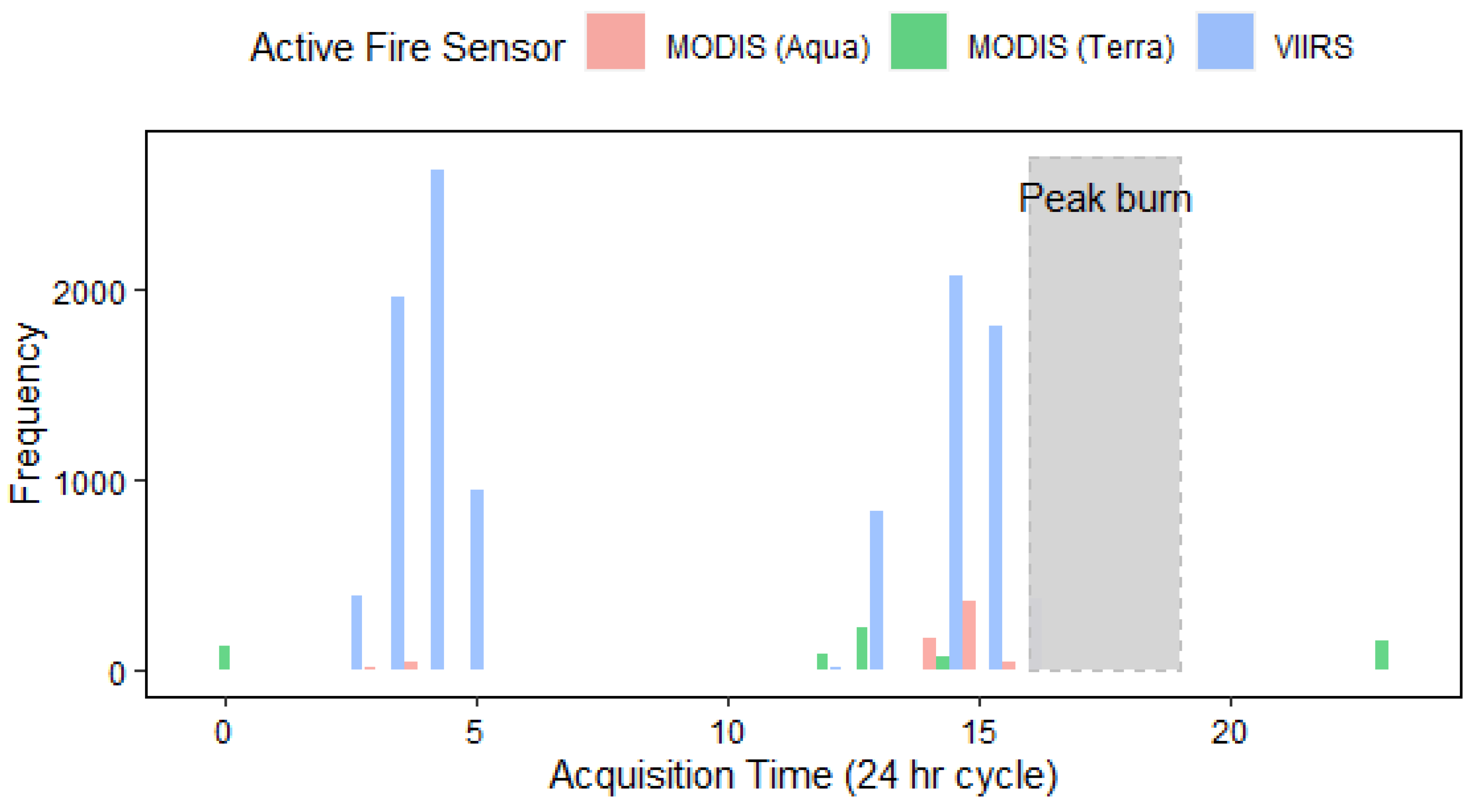
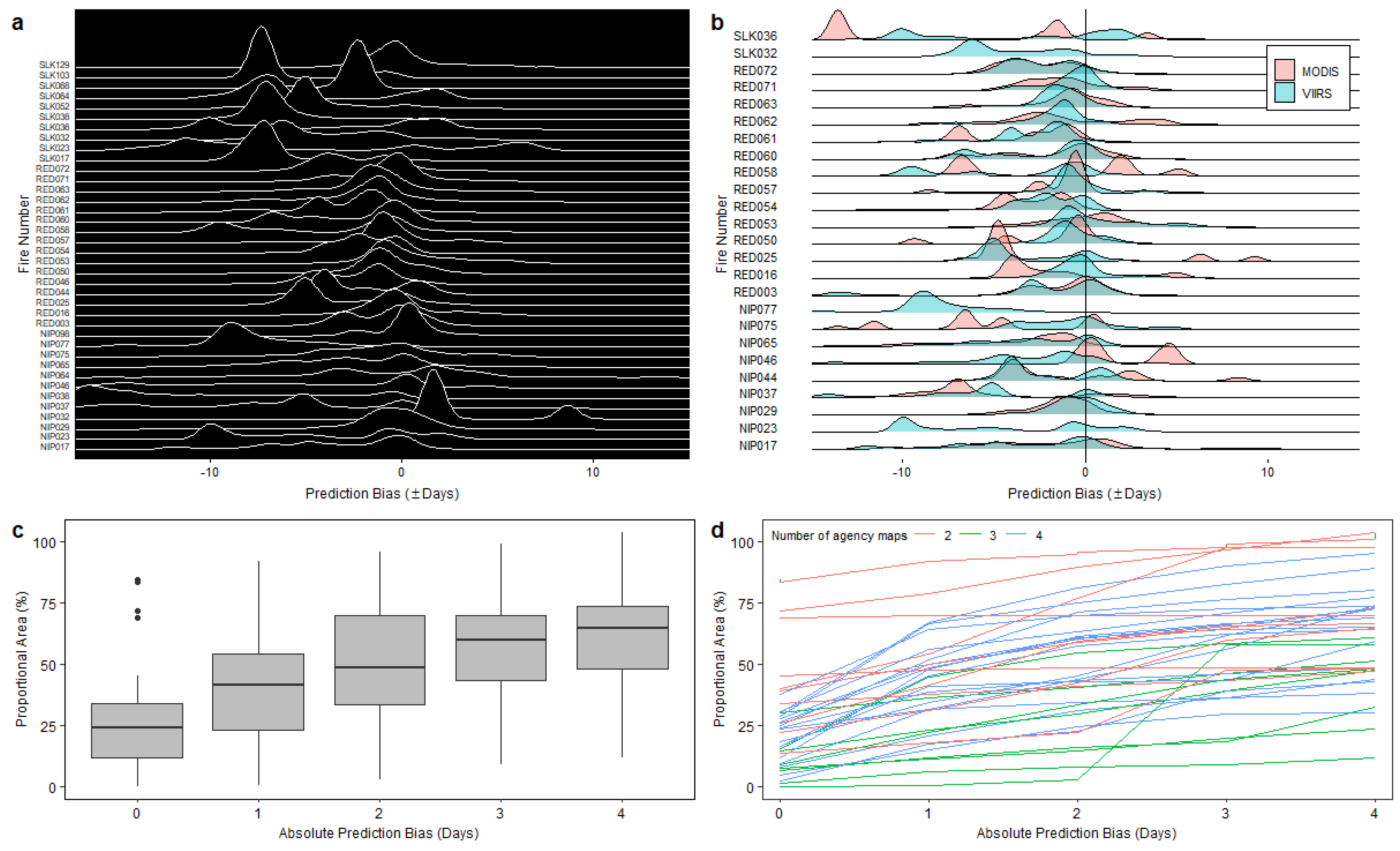
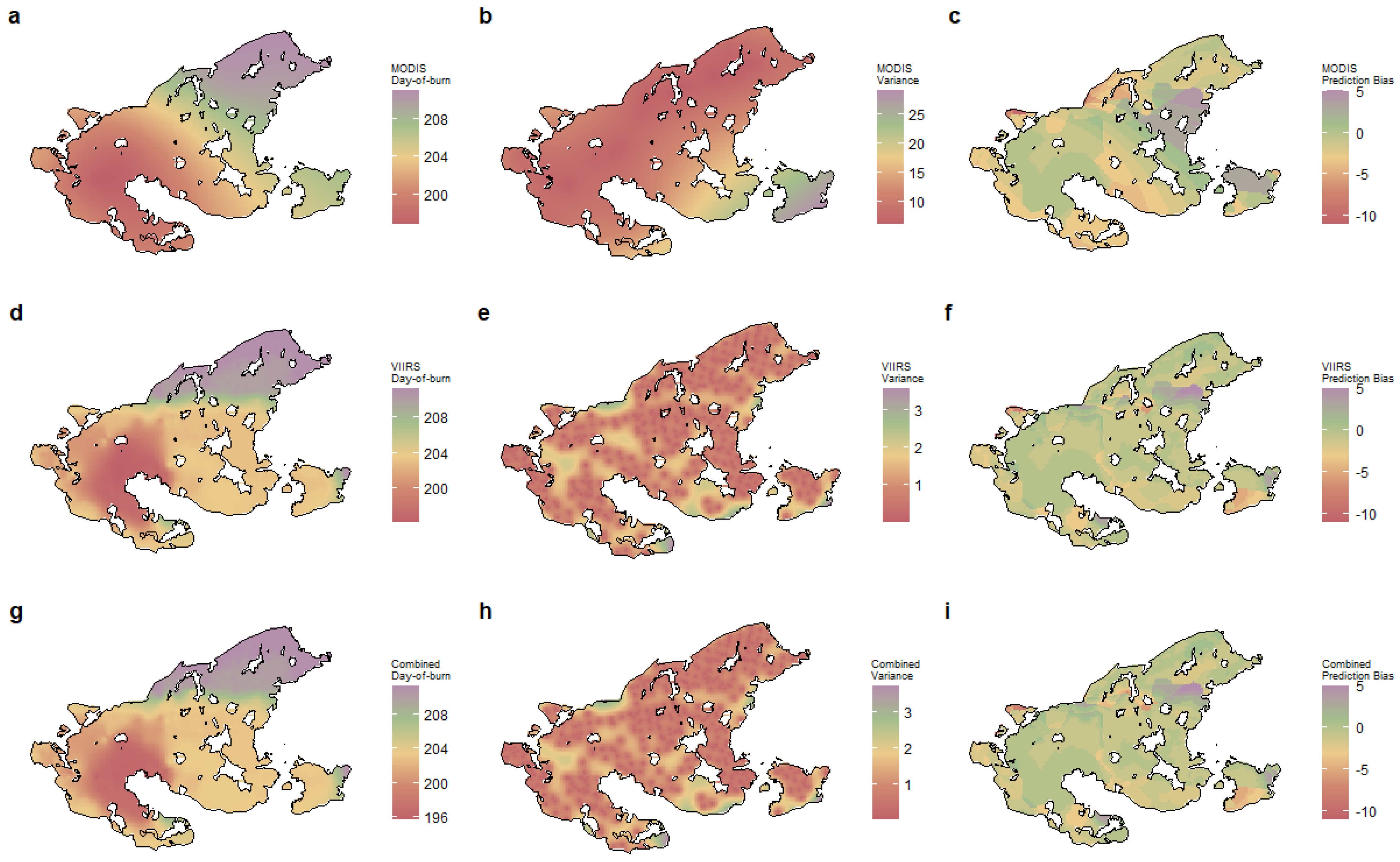
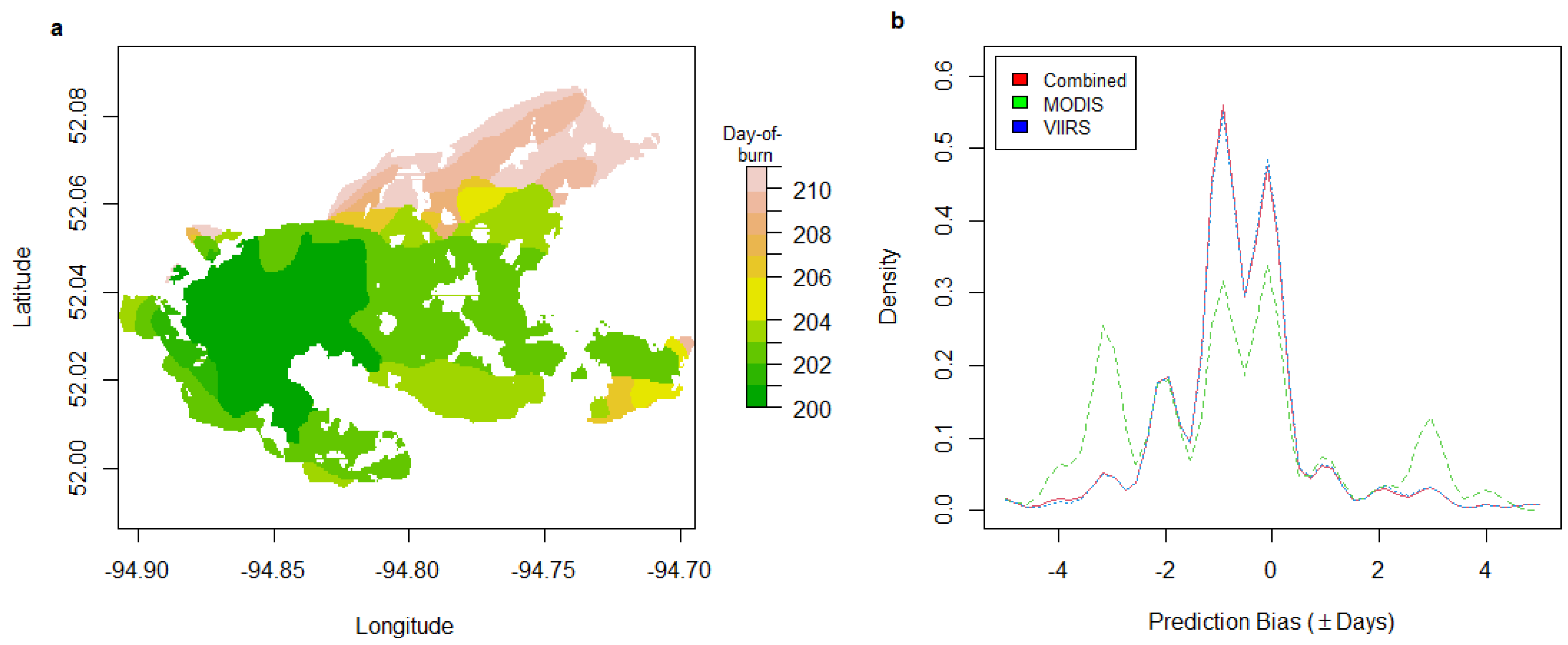
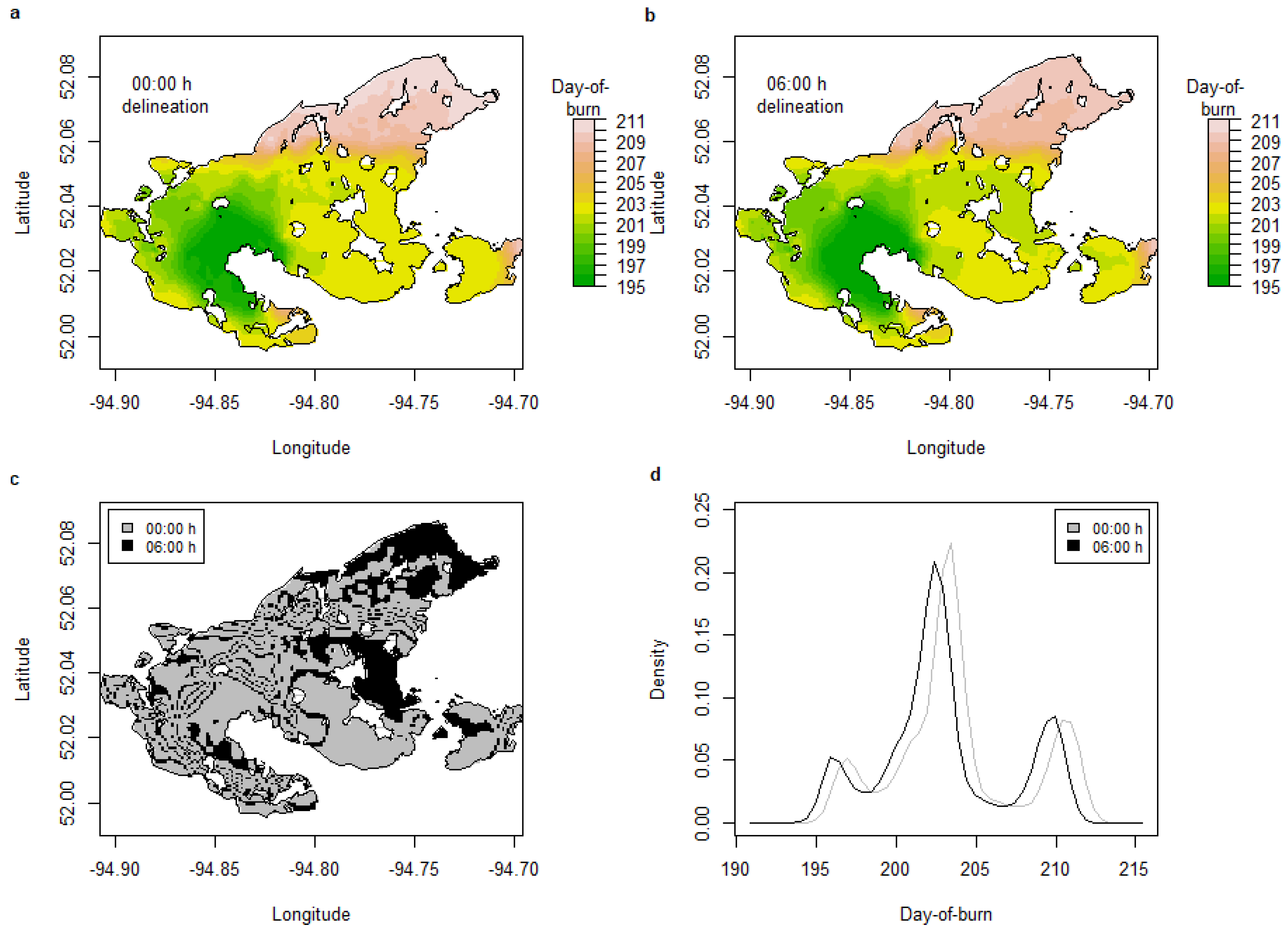
| Research Question | Statistical Approach | Data Sources | Findings |
|---|---|---|---|
| Do weather, topography, vegetation type, and time since last fire affect fire severity? [46] | Regression tree analysis (n = 2 fires) | Landsat | Higher relative humidity, lower temperatures, and a shorter time since the last fire corresponded with low and moderate fire severity. Lodgepole pine stands burning at low wind speeds often had higher mortality rates. |
| Do weather and time since last fire constrain subsequent fire spread? [47] | Categorical tree analysis, logistic regression analysis (n = 19 fires) | Landsat | Low to moderate fire weather and time since fire less than 9 years constrained spread; evidence that fire is “self-limiting”. |
| Characterize the relative importance of weather, topography, and previous burns on crown damage. [48] | Regression tree analysis, random forest (n = 1 fire) | Digital aerial photography | The air temperature and burn period (in weeks instead of days) were associated with high crown damage. |
| Is daily area burned correlated with burn severity? [49] | Correlation (n = 42 fires) | Landsat, airborne thermal infrared scans | The proportion of high burn severity was weakly correlated with the size of the daily burned area. |
| How do Santa Ana wind events affect daily area burned? [50] | Kolmogorov–Smirnov test, t-test, generalized linear model (n = 158 fires) | Landsat, MODIS | Increased wind speed and relative humidity associated with Santa Ana winds were significant predictors of burned area per day. The length of the previous day’s burn perimeter was also a significant predictor. |
| How do potential and realized spread vary across Canada? [51] | Frequency distribution, transformation function, correlation (n = 2246 fires) | MODIS | The ratio of days with fire-conducive weather (Fire Weather Index ≥ 19) to days where actual fire growth was observed varied by region and by latitude. |
| Do previous burns and weather influence subsequent fire spread? [52] | Logistic regression (n = 1038 fires) | Landsat | Fire progression is controlled by previous fires (i.e., lack of flammable fuels) and weather— evidence that fire is “self-limiting”. |
| Characterize the relative importance of top-down (daily fire weather) and bottom-up (topography and vegetation) controls on burn severity. [53] | Multivariable generalized linear regression (n = 6 fires) | Landsat | “Prognostic models indicated burn severity was explained by pre-fire stand structure and composition, topo-edaphic context, and fire weather at time of burning”. |
| Fire Number | Duration | No. of Agency Maps | Fire Area (ha) | Moran’s I | No. of Hotspots | Variogram Parameters | MODIS | VIIRS | Combined | |||||||
|---|---|---|---|---|---|---|---|---|---|---|---|---|---|---|---|---|
| MODIS | VIIRS | Nugget (days2) | Sill (days2) | Range (km) | r | r | k | r | A | R2 | RMSE | |||||
| RED-050-2012 | 196–234 | 6 | 6956 | 0.93 | 34 | 670 | 0 | 14.5 | 5.7 | 0.45 | 0.77 | 0.38 | 0.77 | 0.58 | 0.59 | 2.17 |
| RED-053-2012 | 196–255 | 9 | 18,845 | 0.94 | 480 | 1336 | 0.12 | 15.5 | 4.2 | 0.66 | 0.71 | 0.78 | 0.72 | 0.05 | 0.52 | 2.28 |
| RED-057-2012 | 189–234 | 4 | 2706 | 0.92 | 21 | 182 | 1.04 | 37.3 | 24.9 | −0.01 | 0.38 | 0 | 0.35 | 0.17 | 0.13 | 2.02 |
| RED-058-2012 | 190–234 | 6 | 1884 | 0.98 | 22 | 171 | 0 | 20.7 | 2.9 | −0.24 | 0.32 | 0 | 0.31 | 0.38 | 0.09 | 4.50 |
| RED-060-2012 | 184–234 | 6 | 2742 | 0.97 | 115 | 694 | 1.26 | 124.3 | 55.0 | 0.45 | 0.46 | 0.70 | 0.46 | 0.15 | 0.21 | 2.84 |
| RED-061-2012 | 196–255 | 6 | 956 | 0.93 | 20 | 164 | 2.12 | 5.2 | 1.9 | 0.03 | 0.47 | 0.39 | 0.43 | 0.00 | 0.18 | 2.41 |
| RED-062-2012 | 195–255 | 5 | 1016 | 0.95 | 17 | 94 | 0 | 409.0 | 39.9 | 0.53 | 0.78 | 0.76 | 0.77 | 0.48 | 0.59 | 2.41 |
| RED-063-2012 | 195–255 | 6 | 3577 | 0.93 | 19 | 407 | 1.38 | 115.8 | 22.9 | 0.45 | 0.79 | 0.34 | 0.77 | 0.40 | 0.59 | 1.90 |
| RED-071-2012 | 184–235 | 10 | 6085 | 0.94 | 24 | 414 | 0 | 204.4 | 83.1 | 0.83 | 0.91 | 0.84 | 0.91 | 0.55 | 0.82 | 1.47 |
| RED-072-2012 | 189–285 | 8 | 13,631 | 0.94 | 109 | 1029 | 0.97 | 13.6 | 4.6 | 0.74 | 0.71 | 0.82 | 0.71 | 0.56 | 0.51 | 1.95 |
| NIP-017-2015 | 159–228 | 5 | 15,827 | 0.91 | 37 | 278 | 3.51 | 23.3 | 7.0 | 0.57 | 0.47 | 0.60 | 0.49 | 0.64 | 0.24 | 4.09 |
| NIP-023-2015 | 168–228 | 3 | 4067 | 0.94 | 3 | 122 | 0.38 | 116.5 | 70.8 | - | 0.65 | - | - | - | - | - |
| RED-016-2015 | 166–226 | 5 | 2629 | 0.96 | 22 | 113 | 1.64 | 132.1 | 42.5 | 0.39 | 0.83 | 0.52 | 0.83 | 0.69 | 0.69 | 2.08 |
| RED-025-2015 | 175–226 | 5 | 2189 | 0.92 | 39 | 109 | 0 | 181.3 | 37.2 | 0.07 | 0.83 | 0.30 | 0.83 | 0.00 | 0.68 | 2.88 |
| RED-044-2015 | 177–226 | 5 | 1024 | 0.96 | 10 | 102 | 0 | 57.0 | 50.3 | 0.59 | 0.89 | 0.81 | 0.88 | 0.73 | 0.77 | 2.02 |
| RED-046-2015 | 177–226 | 5 | 333 | 0.97 | 3 | 38 | 0 | 22.4 | 1.31 | - | 0.83 | - | - | - | - | - |
| RED-003-2016 | 126–222 | 8 | 74,334 | 0.78 | 609 | 526 | 0.87 | 208.0 | 707 | 0.87 | 0.64 | 0.91 | 0.88 | 0.70 | 0.78 | 2.48 |
| NIP-029-2017 | 208–270 | 7 | 6999 | 0.92 | 16 | 1088 | 1.01 | 31.6 | 8.8 | 0.79 | 0.83 | 0.70 | 0.83 | 0.60 | 0.69 | 1.80 |
| NIP-032-2017 | 210–262 | 2 | 168 | 0.97 | 0 | 18 | 18.68 | 0.5 | 7.1 | - | −0.05 | - | - | - | - | - |
| NIP-037-2017 | 210–253 | 4 | 3915 | 0.92 | 8 | 299 | 0 | 21.5 | 4.2 | 0.61 | 0.68 | 0.60 | 0.69 | 0.68 | 0.47 | 6.27 |
| NIP-038-2017 | 210–255 | 2 | 205 | 0.95 | 0 | 22 | 3.29 | 83.7 | 5.0 | - | 0.56 | - | - | - | - | - |
| NIP-046-2017 | 212–253 | 2 | 208 | 0.93 | 28 | 119 | 0.49 | 1470.8 | 187.1 | −0.33 | 0.35 | 0 | 0.34 | 0.00 | 0.11 | 1.84 |
| NIP-064-2017 | 220–262 | 3 | 530 | 0.97 | 0 | 60 | 0 | 124.3 | 1.6 | - | 0.73 | - | - | - | - | - |
| NIP-065-2017 | 220–253 | 3 | 3486 | 0.96 | 7 | 394 | 4.08 | 30.6 | 2.5 | 0.70 | 0.74 | 0 | 0.73 | 0.48 | 0.54 | 3.41 |
| NIP-075-2017 | 220–262 | 6 | 674 | 0.95 | 35 | 107 | 9.07 | 978.1 | 56.9 | −0.01 | 0.67 | 0.44 | 0.69 | 0.37 | 0.47 | 3.13 |
| NIP-077-2017 | 210–255 | 2 | 574 | 0.95 | 0 | 54 | 2.40 | 34.7 | 7.3 | - | 0.41 | - | - | - | - | - |
| NIP-098-2017 | 210–255 | 4 | 4736 | 0.93 | 0 | 1066 | 3.51 | 353.3 | 80.8 | - | 0.68 | - | - | - | - | - |
| RED-054-2017 | 215–276 | 2 | 4049 | 0.93 | 56 | 418 | 4.56 | 23.3 | 1.4 | 0.11 | 0.28 | 0.34 | 0.27 | 0.17 | 0.07 | 1.44 |
| SLK-017-2017 | 205–261 | 3 | 3690 | 0.64 | 15 | 253 | 1.76 | 71.7 | 41.4 | −0.01 | 0.10 | 0.29 | 0.10 | 0.67 | 0.01 | 1.35 |
| SLK-032-2017 | 209–248 | 2 | 230 | 0.96 | 0 | 26 | 0 | 35.4 | 0.5 | - | 0.81 | - | - | - | - | - |
| SLK-036-2017 | 210–261 | 4 | 2230 | 0.96 | 14 | 149 | 0 | 20.6 | 4.3 | 0.09 | 0.53 | 0 | 0.54 | 0.42 | 0.30 | 5.63 |
| SLK-038-2017 | 210–261 | 2 | 653 | 0.88 | 0 | 76 | 1.69 | 64.7 | 11.4 | - | 0.37 | - | - | - | - | - |
| SLK-052-2017 | 215–248 | 2 | 1320 | 0.96 | 10 | 88 | 0 | 11.9 | 0.7 | 0.00 | 0.46 | 0.02 | 0.45 | 0.29 | 0.20 | 2.42 |
| SLK-064-2017 | 216–248 | 2 | 132 | 0.94 | 0 | 15 | 1.53 | 5.3 | 0.7 | - | 0.72 | - | - | - | - | - |
| SLK-068-2017 | 217–261 | 2 | 510 | 0.52 | 0 | 69 | 0.37 | 3.8 | 11.5 | - | −0.01 | - | - | - | - | - |
| SLK-103-2017 | 226–261 | 2 | 110 | 0.96 | 0 | 5 | 12.25 | 12.3 | 0.1 | - | 0.65 | - | - | - | - | - |
| SLK-129-2017 | 222–261 | 2 | 121 | 0.98 | 0 | 13 | 0 | 23.9 | 0.3 | - | −0.07 | - | - | - | - | - |
| Fire Number | Start Date | Agency Map Date | Fire Size | First MODIS | First VIIRS | Difference (Days) |
|---|---|---|---|---|---|---|
| RED-057-2012 | 189 | 200 | 125 | 203 | - | 3 |
| RED-058-2012 | 190 | 200–204 | 195, 268, 168 *, 529 | 205 | - | 5 |
| NIP-017-2015 | 159 | 164 | 263 | 174 | 170 | 10, 6 |
| RED-025-2015 | 175 | 176 | 53 | 185 | - | 9 |
| RED-044-2015 | 177 | 184 | 67 | 192 | 186 | 8, 2 |
| NIP-046-2015 | 212 | 234 | 84 | 238 | - | 4 |
| SLK-036-2017 | 210 | 212 | 261 | - | 220 | 8 |
| SLK-052-2017 | 215 | 219 | 104 | 223 | - | 4 |
| NIP-032-2017 | 210 | 211 | 31 | - | 219 | 8 |
| SLK-038-2017 | 210 | 217 | 15 | - | 220 | 3 |
| SLK-129-2017 | 222 | 225 | 599 | - | 226 | 1 |
Disclaimer/Publisher’s Note: The statements, opinions and data contained in all publications are solely those of the individual author(s) and contributor(s) and not of MDPI and/or the editor(s). MDPI and/or the editor(s) disclaim responsibility for any injury to people or property resulting from any ideas, methods, instructions or products referred to in the content. |
© 2024 by the authors. Licensee MDPI, Basel, Switzerland. This article is an open access article distributed under the terms and conditions of the Creative Commons Attribution (CC BY) license (https://creativecommons.org/licenses/by/4.0/).
Share and Cite
Schiks, T.J.; Wotton, B.M.; Martell, D.L. Remote Sensing Active Fire Detection Tools Support Growth Reconstruction for Large Boreal Wildfires. Fire 2024, 7, 26. https://doi.org/10.3390/fire7010026
Schiks TJ, Wotton BM, Martell DL. Remote Sensing Active Fire Detection Tools Support Growth Reconstruction for Large Boreal Wildfires. Fire. 2024; 7(1):26. https://doi.org/10.3390/fire7010026
Chicago/Turabian StyleSchiks, Tom J., B. Mike Wotton, and David L. Martell. 2024. "Remote Sensing Active Fire Detection Tools Support Growth Reconstruction for Large Boreal Wildfires" Fire 7, no. 1: 26. https://doi.org/10.3390/fire7010026






